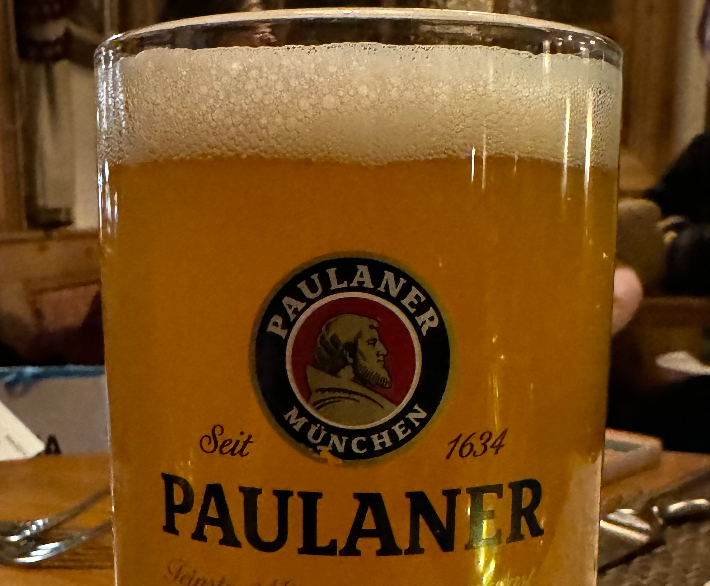
When blogs die: Before getting to some good reading, this. I just counted. I am subscribed to 198 rss feeds, most of them blogs. Most of them out of service. Some now gone for 10 years or so. But you never know when one might return to life. I was briefly excited Friday to see seven posts from one show up in my reader, the first from that blog since 2017. Briefly, because now the site has the tagline “As Essential as Beer, Focused on Sex.” I’m not going to include a link, because I don’t want to embarrass the (former) blogger who let their domain name registration expire, and you can find your own damn porn.
Also Friday, I was just finishing reading a post from Boak & Bailey — in which they asked “What is it about pubs that makes them particularly suitable for socialising and ‘hanging out’, compared to cafes and restaurants?” — when my feed reader delivered the bold assertion that, “Breweries Are Great Third Places. But We Deserve Even Better Ones.”
Later in the day, Stephanie Grant added to the conversation going in in my head with, “Crafting Community in Taprooms: A Dive into Third Spaces.” For those not familiar with Ray Oldenburg’s work that introduced so many to the concept of a third place, she includes his eight characteristics of a third place as outlined in “The Great Good Place.”
Oldenburg wrote another book, published almost 30 years after “The Great Good Place,” called, “The Joy of Tippling: A Salute to Bars, Taverns, and Pubs.” He was cautious about advocating for the use of alcohol.
“The joy of tippling,” he wrote, “the case for which I’m writing and advocating, is most often experienced among the regulars at neighborhood bars. There’s far more conversation than drinking there and it takes place among people from different walks of life who take pride in diversity. To see this all passing away, and too often to the delight of city governments, makes me wonder about the kind of society we are becoming.”
At VinePair, Dave Infante argues that, “The Platonic ideal of a craft brewery is a good third place, and we deserve better ones. We deserve public spaces where buying shit is an option, not an obligation; where alcohol and NA drinks (and other recreational drugs) can be enjoyed safely and socially; where the magic of the public commons, not logic of the market, dictates the terms of engagement.”
A fine idea, but at time in which libraries struggle to remain welcoming, while it is reasonable to keep demanding proper public spaces the wait to see this happen may be long. For the time being, privately owned establishments that minimize the obligation to “buy shit” (or the drink of your choice) and maximize being welcoming are our best option.
You might also enjoy
Murky Waters: Distilling truth from fiction in the Faubourg Brewing debacle
A very long read to start off, but worth your time, and the reason that I made a contribution to support Louisiana Illuminator, part of States Newsroom, a network of news bureaus supported by grants and a coalition of donors as a 501c(3) public charity. Let’s hear it for nonprofit journalism (the kind that pays journalists). Perhaps it is not a coincidence that Drew Hawkins, who reported on this story, has also written ones about the challenges Louisiana libraries face.
It is not just this gem of a truth: “If you’re a private equity investment firm looking to turn a major profit, craft beer isn’t as lucrative as it was a decade ago.”
The story holds the company Made By The Water, accountable for statement after statement that really needed to be challenged. They gutted Catawba Brewing, shut down Faubourg Brewing (formerly Dixie) in New Orleans, and even screwed over a reality TV star.
– Reinheitsgegot, from Bavarian oddity to German icon, 1906-1975
“Throughout the industrialised world, concepts of food ‘purity’ and ‘natural eating’ emerged in the late nineteenth century as life reformers, food scientists, businessmen and regulators eyed the potential harms of the modern food system, from meat-heavy diets to the increasingly adulterated and synthetic alternatives that occupied the growing space between food producers and consumers.” In fact, in the United States there was a battle over what might be called “pure beer.” [h/T Andreas Krennmair]
– How Guinness got women on board and left its lads-only image behind
“It’s not just a drink, it’s an experience. That famous strap-line, ‘good things come to those who wait,’ refers to the two-part pour needed to achieve that perfect creamy head on the beer. Just like when a cocktail is mixed in front of the guest, there is an element of performative theatre to its service.” Related: “How Guinness Led a Modern Nitro-Stout Takeover of Britain’s Pubs.”
– Notes on central European beer – A sign of the times?
“In the past, when I’ve encountered young craft beer markets, there’s a since of excitement and possibility. In this region, breweries are in triage and just trying to get back to normal economies. They’re excited about the beer, but anxious about the market and tired from the long slog.”
– Ideal Day Family Brewery on Crocadon Farm, Cornwall
I must echo Alan McLeod and Boak & Bailey pointing to this story. “All art is the journey back to the point at which your heart first opened.”
– 80+ Black-Owned Breweries to Support Across the Country
“Despite seeing some progress in initiatives over the last four years, such as the creation of the National Black Brewers Association, the fact remains that less than one percent of all craft breweries in the United States are Black-owned.”
– The New, Old Look American Lager
“Rhinegeist doesn’t use the term ‘craft’ on their Cincy Light packaging, but they do use the Brewers Association’s Craft Brewers seal and embrace the term in telling their broader story. Garage Beer, which exited the Braxton Brewing architecture, was given a fresh start and updated design with no real history or other other continuity to factor in. They went with the phrase ‘Small Batch Brewed’ which makes sense as a way to distance themselves from a powerhouse brand like Modelo, which sells at a similar price.’
– As market tightens, local breweries must find their niche
To bring chatter about third places full circle. “At Old Bust Head Brewery in Vint Hill on a recent Saturday, the taproom was lively. Lauren and Jared Fisher were there with their two young daughters playing Old Maid. They moved to the area four months ago from Florida. ‘We’re originally from New York, and I would go out to breweries with my girlfriends on Fridays,’ Lauren Fisher said. ‘Our neighbors recommended this place, so we came here with the girls. It feels a little bit like cheating. We get to have a little bit of fun, and they get to have fun.'”



 You know if you know (at which brewery this request is posted)
You know if you know (at which brewery this request is posted)